|
 |
|
|
|
|
|
|
|
|
|
|
|
|
|
|
|
|
|
| Temples of Delhi |
|
|
| About Delhi |
|
|
 |
|
| Travel Destinations Guide |
|
|
| Adventure Tours India |
|
|
|
|
 |
Biking Tours |
 |
Paragliding |
 |
Skiing |
 |
Safari Tours |
 |
Water Rafting |
 |
Trekking Tours |
 |
Camel Safari |
|
|
| |
|
|
|
|
| |
|
| |
|
|
|
| Culture - Gujarat "The Land of the Legends" |
|
| Back |
The Gujarat state of India, boasts of a rich culture and heritage. The people of Gujarat are very particular regarding their value system. They have preserved the ancient art and craft techniques and still practice them with great determination. Gujaratis are proud of their customs and traditions and follow them with utmost pride. The people of Gujarat are very simple and live life to the fullest. The spirit of Gujarat is quite visible from the varied fairs and festivals celebrated in the state. It is further enriched by the tribal people residing here. They have their own set of customs and rituals. Thus, Gujarat has a cultural diversity which is a unique feature of the state and is randomly seen.
 Garba dance Garba dance
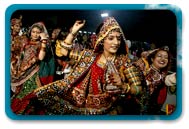 Garba dance is originally a popular folk dance of Gujarat. This dance form has connection with Shakti-Puja and its origin is believed to be in the worship of goddess Jagdamba. It is played in a circular form performed by ladies on the nine nights of Navaratri festival, Sharad Purnima, Vasant Panchami, Holi and such other festive occasions and it continues till midnight. The word Garba is derived from the word `Garbha Deep` (a lamp inside a perforated earthen pot). The light inside the perforated earthen pot symbolizes the embryonic life. This also signifies value of knowledge (light), as opposed to the darkness (ignorance). It is said that just as Lord Krishna popularized the Ras dance, Usha the grand daughter-in-law of Lord Krishna is credited to have popularized Lasya Nritya, which is known today by the name of Garba dance. Garba dance is originally a popular folk dance of Gujarat. This dance form has connection with Shakti-Puja and its origin is believed to be in the worship of goddess Jagdamba. It is played in a circular form performed by ladies on the nine nights of Navaratri festival, Sharad Purnima, Vasant Panchami, Holi and such other festive occasions and it continues till midnight. The word Garba is derived from the word `Garbha Deep` (a lamp inside a perforated earthen pot). The light inside the perforated earthen pot symbolizes the embryonic life. This also signifies value of knowledge (light), as opposed to the darkness (ignorance). It is said that just as Lord Krishna popularized the Ras dance, Usha the grand daughter-in-law of Lord Krishna is credited to have popularized Lasya Nritya, which is known today by the name of Garba dance.
In this folk dance, the women place the pot known as Garba with the lamp on their heads and move in circular direction, singing and clap at the same time or even snap their fingers, to the accompaniment of folk instruments. A betel nut and a silver coin are placed within the pot, termed as Kumbh, on top of which a coconut is placed. Even in some villages of Gujarat, one would find the tradition of a "Light" (Deevo-Kodiyun) in an earthen pot with the holes all around, placed in the center on a stool and colourful dressed ladies dancing around it by clapping their hands and singing Mataji`s songs. Garba songs are devotional mostly in praise of Mother Goddess Jagdamba describing her form, powers, and invoking her blessings. But in some songs description about seasons and social themes of domestic life is also found. Folk poets compose Garba songs, which are lyrical poems sung in praise of Lord Krishna. Singing together is an invariable accompaniment of Garba Nrtiya. Other forms of Garba are Deevo, Ghado and Garbi.
 Music Music
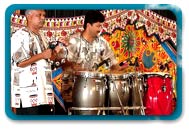 Gujarat is a state of music lovers and has produced some of the best musicians of India. It is said that the legendary musicians Baiju Bawra and Tana Riri belong to the state itself. Narsinh Mehta, of the 'Vaishnav Janto' acclaim, also hails from Gujarat. He was a Vaishnavite poet of Junagadh and wrote songs in the praise of the Lord. His Gujarati compositions had a profound influence on the devotees. It is believed that he came in communion with Lord Krishna when he sung 'Raag Kedar'. 'Vaishnav Janto' was very dear to Gandhiji also and remains a musical marvel till date. Gujarat is a state of music lovers and has produced some of the best musicians of India. It is said that the legendary musicians Baiju Bawra and Tana Riri belong to the state itself. Narsinh Mehta, of the 'Vaishnav Janto' acclaim, also hails from Gujarat. He was a Vaishnavite poet of Junagadh and wrote songs in the praise of the Lord. His Gujarati compositions had a profound influence on the devotees. It is believed that he came in communion with Lord Krishna when he sung 'Raag Kedar'. 'Vaishnav Janto' was very dear to Gandhiji also and remains a musical marvel till date.
Besides, Gujar Tod, Bilaval and Khambhavati are the names associated with Gujarat. Veraval and Cambay are also state's contributions to classical music. Musicians like Ustad Faiyazkhan, Maulabux, the 'Been' player Rahim Khan and many others have shone the name of the state in the field of music. Apart from this, Pandit Omkarnath Thakur, one of the greatest exponents of Indian classical music, is also from Gujarat. Dahyalal Shivram's Sangeet Kaladhar and Adityaram Vyas's Sangeetaditya have also made significant contributions to Gujarati music.
 Religion Religion
 A Gujarati Hindu attaches the greatest importance to bathing. He or she observes fasts once a week and every eleventh day in a fortnight. A Gujarati Hindu believes in Heaven, Hell, and the transmigration of the soul. One hopes to better one's position in this and the life to come by one's devotion to God, by dan (charity), and by daya (mercy toward fellow human beings and cows, etc.). A Gujarati Hindu attaches the greatest importance to bathing. He or she observes fasts once a week and every eleventh day in a fortnight. A Gujarati Hindu believes in Heaven, Hell, and the transmigration of the soul. One hopes to better one's position in this and the life to come by one's devotion to God, by dan (charity), and by daya (mercy toward fellow human beings and cows, etc.).
Gujarati Jains, though few in number, occupy an important place in Gujarati society and the economy. Jainism rejects the authority of the Vedas and the spiritual supremacy of the Brahmans. The highest goal of Jainism is nirvana or moksha, the setting free of the individual from the sanskara, the cycle of birth and death. The Jains are divided into two sects, Digambaris and Svetambaris. The cow is worshiped and considered sacred by Hindus. Besides worshiping various idols, an average Hindu worships animals, trees, fire, etc. and believes in bhuts (possessing spirits). Belief in omens is also common. Hindus believe that the result of every undertaking is foreshadowed by certain signs and hints.
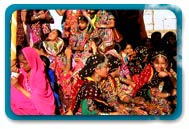  People of Gujarat People of Gujarat
The Gujarat people speaks in three Indian languages: Gujarati, Urdu and Sindhi. There are eleven linguistic sub variants of the Gujarati dialect. The linguistic variation is based on geographical factors.
People in north Gujarat speaks a different linguistic variation of the Gujarati language when compared with the people of south Gujarat. The Gujarati language has a different flavor in central or western Gujarat. The Gujarat people seems to speak in different tongues even when they are speaking the same language-Gujarati!
There are three principal religious groups among the Gujarat people: Hindus, Muslims and Jains. The Hindus are predominant among the Gujarat people. A small minority of Gujarat people are Zoroastrians or Parsis.
The Hindu religious order is strictly followed among the Gujarat people who follow the Hindu religion.
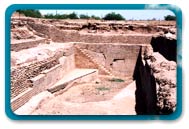  History History
The history of Gujarat is an illustrious one. The history of Gujarat state comprises an important part of Indian historical texts.
Gujarat finds mention in ancient historical artifacts. The history of Gujarat encompasses the Indus Valley civilization. The history of Gujarat is replete with the mementos and associated artifacts of the ancient civilization. About 50 Harappan settlement ruins were discovered in Gujarat.
The Dravidian tribes were the original inhabitants of the region. The ancient history of Gujarat was enriched by their commercial activities. There is a clear historical evidence of trade and commerce ties with Sumer in the Persian Gulf during the time period of 1000 to 750 BC.
The history of Gujarat saw an Aryan invasion followed by a brief period of Greek rule. There were a succession of Hindu kingdoms including the era of the Guptas and culminating in the reign of the Solankis.
The 9th century history of Gujarat saw the emergence of the Muslims in the political arena of the state. The first Muslim conqueror was Mohammad of Ghazni whose conquer of Somnath effectively ended the rule of the Solankis. The Mughals established and consolidated their rule from Delhi The rule of the Mughals lasted for two centuries before it was ended by the Marathas in the 18th century.
The Muslim reign comprised the medieval period in the history of Gujarat.
The British Raj got a toehold in the region in the year 1803. The Union Jack consolidated its rule by 1827. The East India Company resurrected the principal trading post of Surat before transferring the administrative seat to Bombay (now Mumbai).
After gaining independence in 1947, the Indian National Congress party (INC) ruled the Bombay state (which included present-day Gujarat and Maharashtra). Congress continued to govern Gujarat after the state's creation in 1960. During and after India's State of Emergency of 1975-1977, public support for the Congress Party eroded, but COngress continued to hold government until 1995.
Gujarat has had 14 different Chief Ministers since its formation in 1960. Dr. Jivraj Narayan Mehta 1 May 1960 - 19 September 1963 of Indian National Congress was the first Chief Minister. In the 1995 Assembly Polls, the Congress lost to the BJP and Keshubhai Patel came to power.
In 2001, following the loss of 2 assembly seats in by-elections, Keshubhai Patel resigned and yielded power to the present Chief Minister Narendra Modi. The BJP retained a majority in the 2002 election, and Narendra Modi has since served as Chief Minister of the state since 7 October 2001 upto present. On 1st June, 2007, Narendra Modi became the longest serving Chief Minister of Gujarat.
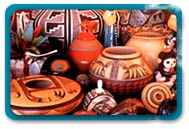  Handicrafts Handicrafts
Gujarat is blessed with rich and vibrant tradition of Handicrafts. It is widely differing in its proportions of its patterns to the element of wonderful exquisite Artifacts in various forms. It stands unique with diverse arts and crafts - a mixed combination with aesthetic appeal.
Needlework of Gujarat is famous world over for its elegance and accuracy. Embroidery is Gujarat's quintessential handicraft and many of the artisans are wives of herdsmen, nomads and agriculturists battling for a second income. Ari bharat, appliqué work are unique with its traditional skills. Toran is the most common embroidered doorway decoration with hanging flaps, which is supposed to ventilate good luck.Beadwork is another Gujarati specialty from Khambhat and Saurashtra. Motifs and patterns are dictated by the technique of putting two and three beads together. Beadwork objects are used in wall decorations, potholders, etc. The best beadwork is produced by the 'kathis' (tribals).
|
| Back |
|
|
|
|
|
|
|
|
|
|
|
|
|
|
